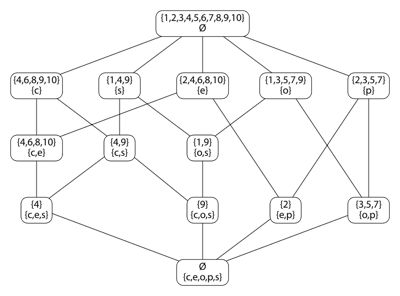Lattice
A Concept lattice' or formal concept analysis is a principled way of automatically deriving an ontology from a collection of objects and their properties. The term was introduced by Rudolf Wille in 1984, and builds on applied lattice and order theory that was developed by Birkhoff and others in the 1930's.
Intuitive description
Formal concept analysis refers to both an unsupervised machine learning technique and, more broadly, a method of data analysis. The approach takes as input a matrix specifying a set of objects and the properties thereof, called attributes, and finds both all the "natural" clusters of attributes and all the "natural" clusters of objects in the input data, where
- a "natural" object cluster is the set of all objects that share a common subset of attributes, and
- a "natural" property cluster is the set of all attributes shared by one of the natural object clusters.
Natural property clusters correspond one-for-one with natural object clusters, and a concept is a pair containing both a natural property cluster and its corresponding natural object cluster. The family of these concepts obeys the mathematical axioms defining a lattice, and is called a concept lattice (in French this is called a Treillis de Galois because the relation between the sets of concepts and attributes is a Galois connection).
Note the strong parallel between "natural" property clusters and definitions in terms of individually necessary and jointly sufficient conditions, on one hand, and between "natural" object clusters and the extensions of such definitions, on the other. Provided the input objects and input concepts provide a complete description of the world (never true in practice, but perhaps a reasonable approximation), then the set of attributes in each concept can be interpreted as a set of singly necessary and jointly sufficient conditions for defining the set of objects in the concept. Conversely, if a set of attributes is not identified as a concept in this framework, then those attributes are not singly necessary and jointly sufficient for defining any non-empty subset of objects in the world.
Example
Consider O = {1,2,3,4,5,6,7,8,9,10}, and A = {composite, even number, odd number, prime number, square number. The smallest concept including the number 3 is the one with objects {3,5,7}, and attributes odd number, prime number, for 3 has both of those attributes and {3,5,7} is the set of objects having that set of attributes. The largest concept involving the attribute of being square is the one with objects {1,4,9} and attributes {square}, for 1, 4 and 9 are all the square numbers and all three of them have that set of attributes. It can readily be seen that both of these example concepts satisfy the formal definitions below
The full set of concepts for these objects and attributes is shown in the illustration. It includes a concept for each of the original attributes: the composite numbers, square numbers, even numbers, odd numbers, and prime numbers. Additionally it includes concepts for the even composite numbers, composite square numbers (that is, all square numbers except 1), even composite squares, odd squares, odd composite squares, even primes, and odd primes.[1]
